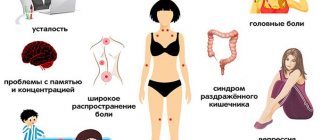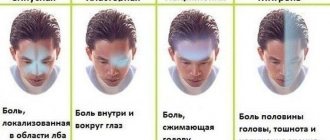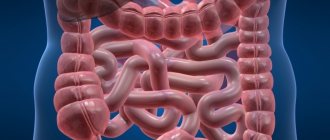Pain in the forearms can be caused by ischemia, inflammation, compression, impaired innervation, traumatic exposure, etc. Particular concern should be caused by pain in the forearm of the left hand, since it may be associated with impaired blood supply to the heart muscle. A similar symptom often appears during an attack of unstable angina. In this case, a person has a pressing dull or sharp dagger pain in the sternum area. If such symptoms appear, it is necessary to call a cardiology ambulance team as soon as possible.
Sudden pain in the right forearm may be a sign of carpal tunnel syndrome or carpal valve syndrome. Cubital tunnel syndrome may also occur. When carrying out differential diagnosis, the possibility of a traumatic violation of the integrity of the tissues of the upper limb should be excluded. With a fracture or crack of the radius or ulna, acute pain syndrome also occurs. It can grow gradually, as blood accumulates inside the tissues or traumatic swelling increases due to disruption of the movement of lymphatic fluid.
Pain in the forearms of both hands is generalized. The cause of its appearance may be cervical osteochondrosis with radicular syndrome, stenosis of the spinal canal at the level of the cervical spine, plexitis or plexopathy of the brachial plexus, acute or chronic cardiovascular failure, impaired outflow of lymphatic fluid, infection or tumor (including in the structures of the brain). brain). Numbness and pain in the forearms of both hands is often associated with the development of systemic lupus erythematosus, Raynaud's syndrome, scleroderma, vasculitis, etc.
The forearm is an anatomical part of the upper limb, which is connected to the hand via the wrist joint and to the shoulder via the elbow joint. Anatomically, it is formed by two bones: the ulna and the radius. Large arteries and veins, the median, radial and ulnar nerves pass here.
The muscles located here are responsible for flexion, extension, pronation and rotation of the hand. The passing nerves are responsible for the innervation of the fingers, providing their fine motor skills and sensory function. Damage to the nerve fiber in the forearm, elbow and wrist joints is the most common cause of pain. In second place in terms of frequency of distribution is damage to soft tissues - cartilage, ligament, tendon and muscle. Developing tendinitis or tendovaginitis, myositis can cause severe pain and limited mobility. Pinched nerve fibers in the cubital, wrist or carpal tunnel lead to pain gradually being accompanied by a feeling of numbness, decreased muscle strength and loss of primary motor skills.
To diagnose the disease that provoked the appearance of pain in the forearm, you need to contact an orthopedist or neurologist. In Moscow, you can make a free appointment with these doctors at our manual therapy clinic. Here you will be given an accurate diagnosis and given recommendations for further examination (if necessary) or full treatment.
Symptoms
The vulnerability of the shoulder joint is due to its excessive mobility and functionality. As a result, uncharacteristic or excessive physical activity can lead to inflammatory and destructive processes in the joint.
A large number of people, of any age category, complain of painful sensations. You can often hear about this symptom from older people, however, young people who lead a sedentary lifestyle also suffer from shoulders. As a rule, shoulder pain occurs due to damage to the shoulder joint.
It is easy to determine what a person is dealing with when experiencing pain: pathology of the shoulder joint or something else, by performing the following manipulations:
If, when moving the shoulder, pain occurs precisely there, in this case it can be said with a high probability that there is a pathology of the shoulder.
If, when turning the neck in different directions, the shoulder reacts to such actions, most likely, we are not talking about damage to the shoulder joint.
Tendinitis
This disease affects the tendons. The pain in the left forearm due to tendonitis most often affects athletes and those who overexert their arms. Rarely does tendonitis occur alone; it usually accompanies a sprain or injury to the upper extremities.
In the first few minutes after the injury, the pain will be intense, but then gradually weaken. This symptom sometimes has a wave-like character. Whenever you try to tense your muscles, you feel a shooting sensation.
Etiology, causes of pain in the shoulders and forearms
There are many causes of pain in the shoulder and forearm, however, we suggest focusing on the most common ones.
- Shoulder arthritis
Arthritis refers to inflammatory diseases of the joints. A person feels acute pain, which becomes stronger in the evening and at night. If treatment is not promptly addressed, the neglected problem will lead to joint destruction and, as a result, disability.
- Shoulder arthrosis
Arthrosis is considered a degenerative disease that gradually destroys articular cartilage, as a result of which a person not only experiences pain, but also becomes limited in his movements. In the most advanced situations, the joint can become completely immobile.
- Bursitis
Bursitis is a disease that is accompanied by an inflammatory process in the bursae surrounding the joint and consisting of connective tissue. In this case, significant swelling is noted. Bursitis is characterized by shooting, throbbing or aching pain in the shoulder and forearm, worsening at night.
- Neuritis
Neuritis is associated with an inflammatory process occurring in the peripheral nerves. The disease is characterized not only by pain, but also by loss of sensitivity, paralysis and paresis in more advanced situations.
- Rotator cuff lesion
As a rule, such a disease is caused by non-standard hand manipulations that have taken place over a long period of time. The lesion is characterized by sharp pain in the shoulder.
- Shoulder impingement syndrome
The disease is associated with the process of deposition of calcium salts. The syndrome is characterized by spontaneous severe pain, which is constant, at the moment when a person moves the shoulder away from the body.
- Tendobursitis, tendinitis
Tendobursitis is an inflammatory process that occurs in the shoulder joint bursa, caused by deposits of calcium salts. As a rule, the disease is characterized by acute pain in the shoulder. The person also experiences restrictions in movement.
Tendinitis is an inflammation of the tendons that surround the shoulder joint. The disease occurs due to heavy loads and is characterized by aching pain.
- Shoulder sprain
Sprains usually occur due to excessive physical activity, resulting in instability of the shoulder joint. This situation often leads to more serious injuries if appropriate treatment measures are not taken in a timely manner. Pain in this case occurs when the shoulder joint moves.
- Humeroscapular periarthrosis
This disease is expressed in the stiffness of the muscles that are located around the shoulder joint, as a result of which the person experiences burning, shooting or aching pain. At night with this disease it is almost impossible to sleep. In addition, hand dysfunction is possible.
- Cervical osteochondrosis
Cervical osteochondrosis affects intervertebral discs, as well as cartilage. When the disease occurs, aching pain occurs in the shoulder, radiating to the forearm.
We looked at the most common causes of pain in the shoulder and forearm. However, sometimes the pain is not related to shoulder problems. This occurs in cases where the source is located in a different location. So, we are talking about referred pain that occurs due to cardiovascular diseases, tumors and various pathologies.
It is impossible to determine the cause on your own, so the best option would be to contact a specialist.
Diagnostics
Patients with forearm pain are examined by orthopedic traumatologists. In case of purulent lesions, patients are referred to surgeons, in case of pain syndrome of neurological etiology - to neurologists. The diagnostic program includes a survey and physical examination, during which the condition and functions of the limb are assessed, deformity, pathological mobility, swelling and other symptoms are identified. The following procedures may be prescribed:
- X-ray of the forearm.
Performed for severe traumatic injuries, suspected osteomyelitis, periostitis, benign and malignant tumors. In other conditions, it is often performed to exclude changes in bone tissue. Detects violations of bone integrity, areas of compaction, rarefaction, etc. - CT scan of bone. Effective when examining solid structures. It is carried out when the results of radiography are ambiguous. Allows you to clarify the size and location of the pathological focus, detect even minor changes, and build a three-dimensional model of the affected area.
- MRI
. Like computed tomography, it is used in the final stages of the examination. On MRI of the bone, changes in the periosteum are clearly visible. Soft tissue MRI shows signs of inflammation or degeneration in the muscles and tendons. - Electrophysiological studies
. EMG, ENG and ENMG are indicated if a neurological etiology of the pain syndrome is suspected. They make it possible to determine the level of nerve damage, assess nerve conduction, and the condition of the innervated muscles. - Lab tests
. In case of purulent lesions, it is possible to assess the severity of inflammation. In rheumatoid arthritis, specific markers are identified. In oncological processes, they are prescribed to assess the general condition of the body and the degree of dysfunction of various organs.
Types of pain
Next, we propose to consider the nature of the pain syndrome.
Acute pain
This pain often radiates to the arm and becomes stronger when the person turns his head. Also, such sensations intensify at night and are sometimes unbearable. In the most severe cases, the person is unable to raise his arm.
Chronic pain
Chronic pain syndrome is characterized by constant discomfort, sometimes turning into aching sensations. In this case, the pain may become stronger when a person begins to feel the muscles. There are also often complaints of a feeling of “ache” in the shoulder joint.
Aching sensations
Aching pain is characterized by constant and often unbearable sensations in the shoulder and forearm. Sometimes the pain is described as burning or shooting. In the most difficult situations, hand dysfunction may be present.
Discomfort when moving
In this case, the pain is characterized by suddenness. Unpleasant sensations have a pronounced color, are distinguished by intensity and constancy.
Injuries
In the right forearm, pain often appears after an injury. Often this is a blow or bruise, which can happen both at home and at work or while playing sports.
Symptoms will depend on the severity of the injury. With bruises or sprains, the pain is usually insignificant, but with fractures it can be very severe, and there is also deformation of the arm.
Treatment depends on the severity of the injuries sustained. Most often it is conservative, but in case of fractures or complete rupture of the tendon, surgery is also possible.
Prevention of shoulder and forearm pain
If a person has pain in his shoulders and forearms, sooner or later he begins to think about what to do. However, it is much easier to prevent certain diseases than to treat them later. Thus, the prevention of pain in the shoulder and forearm is constant movement in everyday life. However, even here it is worth considering the nuances. In particular, you should avoid harming the shoulder joint with unilateral movements, excessive physical exertion, and raising your arms above your head.
With the help of special physical training, you can easily strengthen the shoulder joint and also make it mobile. It is worth paying attention to exercises that are aimed at stretching the shoulder and pectoral muscles. Those who want to do strength training should contact a professional trainer who will supervise the exercises.
People who have to work in an office, spending a lot of time at a desk, should take breaks from time to time to move around and do a few muscle stretching exercises. It is also always worth making sure that your shoulders are relaxed and your posture remains straight.
Osteomyelitis
Aching pain can appear against the background of osteomyelitis. This is an inflammatory disease of bone tissue, leading to its complete destruction. The main reason is hematogenous penetration of microbes into bone tissue.
Osteomyelitis is often not an independent disease, but serves as a complication of fractures, surgical interventions, and injuries. It all starts with aching pain, which then becomes so intense that it does not respond to painkillers.
Abscesses appear in the area of inflammation. Without treatment, fistulas form in their place, through which the contents of the abscess flow out.
Therapeutic measures
What to do to treat pain in the forearm area? Therapeutic measures are aimed at eliminating symptoms and the causes of the pathological process. Pain syndrome can be treated with medications, surgical methods, physiotherapy, and traditional methods. Therapy indicated:
- non-steroidal and steroidal drugs that relieve inflammation;
- analgesics;
- spasiolytics;
- antibiotics;
- antihypoxants;
- β-blockers;
- nitrates;
- chondroprotectors;
- statins;
- antimycotics;
- anticoagulants;
- fibrinolytics.
Surgical methods of treatment are carried out using stenting with shunting; also, according to indications, sympathectomy is performed, a neoplasm is removed that compresses nerve tissue and clogs blood vessels.
In severe cases, if gangrene has occurred, primary or secondary metastases have occurred, the upper limb is severely frostbitten, it must be amputated
Physiotherapy is carried out using electrophoresis, magnetic laser therapy, UHF, shock wave therapy, and acupuncture. Massage procedures with exercise therapy are prescribed.
Traditional methods
Before using these methods, you should consult with your doctor; these methods can be applied in addition to the main treatment. You can take 0.5 liters of water with a tablespoon of vinegar, then moisten a linen napkin, apply a compress to the affected area, which is wrapped.
An ointment is prepared from rendered pork lard. Add finely chopped cinquefoil grass with dry St. John's wort, 3 teaspoons each; 1 tablespoon of red pepper is required. The ingredients are mixed and the affected area is lubricated. Use an infusion consisting of 3 tablespoons of lilac flowers, a tablespoon of burdock root, three pods of hot pepper, 1 liter of alcohol. Leave for no more than a day; local rubbing is indicated.











